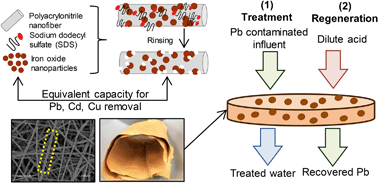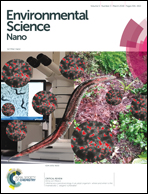Surfactant-assisted fabrication of porous polymeric nanofibers with surface-enriched iron oxide nanoparticles: composite filtration materials for removal of metal cations†
Abstract
We demonstrate a mechanically robust and highly reactive water filter for treatment of cationic heavy metals (lead, copper, cadmium), using a surface-segregating surfactant to fabricate polymer nanofiber composites with embedded, surface-active iron oxide nanoparticles. The single-pot synthesis integrates commercially-available ∼3 nm amorphous iron oxide nanoparticles, sodium dodecyl sulfate (SDS), and polyacrylonitrile (PAN). Characterization suggested the benefits of SDS inclusion are two-fold. During electrospinning, SDS surface-segregation facilitates nanoparticle transport to nanofiber surfaces, thereby enhancing iron oxide surface concentration in the composite. Subsequent rinsing in water leads to SDS release from the polymer; thus, SDS also serves as a removable porogen that enhances composite pore volume. Metal removal performance was evaluated via kinetic, isotherm, and pH-edge sorption experiments, with benchmarks to nanofiber supports (unmodified PAN, SDS-modified PAN) and freely dispersed nanoparticles. SDS–iron oxide nanoparticle synergies enhanced the structural integrity and metal uptake capacity of composites. Notably, for the optimal precursor formulation (7 wt% PAN, 2 wt% iron oxide nanoparticles, 1 wt% SDS), embedded nanoparticles exhibited reactivity comparable to that of nanoparticle suspensions. Treatment of lead at drinking water-relevant concentrations (μg L−1) in a flow-through filtration system revealed that a relatively small amount of material can provide an individual's annual drinking water requirement (∼5 g composite per L per day for tap water containing ∼300 μg L−1 Pb), and effective regeneration can be achieved with small volumes of dilute acid (∼0.6 L of 0.1 N HNO3 per g composite). This work demonstrates the potential of surface-segregating surfactants and porogen-assisted fabrication of electrospun composites to allow practical deployment of nanoparticles within stand-alone, reactive filtration devices.



 Please wait while we load your content...
Please wait while we load your content...